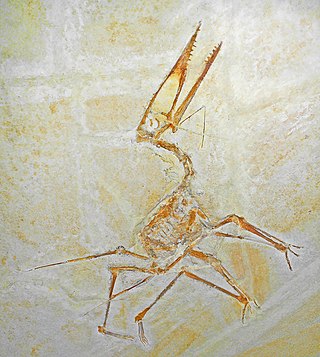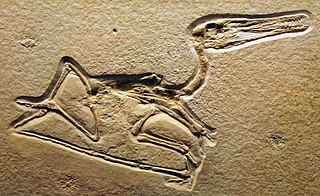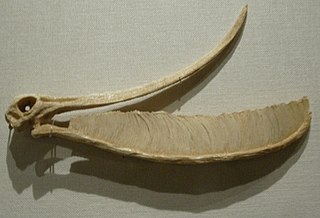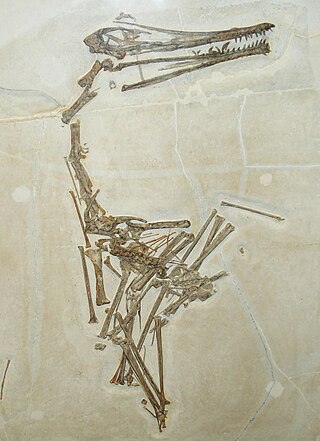
Germanodactylus is a genus of germanodactylid pterodactyloid pterosaur from Upper Jurassic-age rocks of Germany, including the Solnhofen Limestone. Its specimens were long thought to pertain to Pterodactylus. The head crest of Germanodactylus is a distinctive feature.

Pterodactyloidea is one of the two traditional suborders of pterosaurs, and contains the most derived members of this group of flying reptiles. They appeared during the middle Jurassic Period, and differ from the basal rhamphorhynchoids by their short tails and long wing metacarpals. The most advanced forms also lack teeth, and by the late Cretaceous, all known pterodactyloids were toothless. Many species had well-developed crests on the skull, a form of display taken to extremes in giant-crested forms like Nyctosaurus and Tupandactylus. Pterodactyloids were the last surviving pterosaurs when the order became extinct at the end of the Cretaceous Period, together with the non-avian dinosaurs and most marine reptiles.
Boreopterus is a genus of boreopterid pterodactyloid pterosaur from the Barremian-Aptian-age Lower Cretaceous Yixian Formation of Dalian, Liaoning, China.

Cycnorhamphus is a genus of gallodactylid ctenochasmatoid pterosaur from the Late Jurassic period of France and Germany, about 152 million years ago. It is synonymous with the genus Gallodactylus.

Diopecephalus is a genus of pterodactyloid pterosaur from the Lower Tithonian of the Lithographic Limestone, Bavaria, Germany. The type and only species is D. kochi, although the name has been applied to Pterodactylus longicollum, with longicollum erroneously listed as the type species.

Feilongus is an extinct genus of ctenochasmatid pterodactyloid pterosaur from the Barremian–Aptian-age Lower Cretaceous Yixian Formation of Beipiao, Liaoning, China.

Lonchodectidae or Lonchodraconidae is a group of pterosaurs within the clade Pterodactyloidea. It has variously been considered to be within Ctenochasmatoidea, Azhdarchoidea and Pteranodontia. They are notable for their high, conical tooth sockets and raised alveolar margins.

Ctenochasmatoidea is a group of early pterosaurs within the suborder Pterodactyloidea. Their remains are usually found in what were once coastal or lake environments. They generally had long wings, long necks, and highly specialized teeth.

Azhdarchoidea is a group of pterosaurs within the suborder Pterodactyloidea, more specifically within the group Ornithocheiroidea. Pterosaurs belonging to this group lived throughout the Early and Late Cretaceous periods, with one tentative member, Tendaguripterus, that lived in the Late Jurassic period. The largest azhdarchoids include members of the family Azhdarchidae, examples of these are Quetzalcoatlus, Hatzegopteryx, and Arambourgiania. The Azhdarchoidea has been recovered as either closely related to the Ctenochasmatoidea, as the sister taxon of the Pteranodontoidea within the Ornithocheiroidea, or within the Tapejaroidea, which in turn was also within the Ornithocheiroidea.

Ornithocheiridae is a group of pterosaurs within the suborder Pterodactyloidea. These pterosaurs were among the last to possess teeth. Members that belong to this group lived from the Early to Late Cretaceous periods, around 140 to 90 million years ago.

Zhenyuanopterus is a genus of boreopterid pterosaur which is known from Lower Cretaceous Yixian Formation of Liaoning, China. It contains one species, Zhenyuanopterus longirostris, which was first described and named by Lü Junchang.

Euctenochasmatia is an extinct group of pterodactyloid pterosaurs. It was named by David Unwin in 2003 as the group that contains the most recent common ancestor of Pterodactylus and Ctenochasma, and all their descendants.

Boreopteridae is a group of pterodactyloid pterosaurs from the Aptian-age Lower Cretaceous Yixian Formation of Liaoning, China.

Germanodactylidae is a controversial group of pterosaurs within the suborder Pterodactyloidea. It was first named by Yang Zhongjian in 1964, and given a formal phylogenetic definition in 2014 by Brian Andres, James Clark, and Xu Xing. They defined it as the least inclusive clade containing Germanodactylus cristatus and Normannognathus wellnhoferi, which they considered to be close relatives at the time. However, more recent studies by the same researchers have found that these pterosaurs may be only distantly related.

Eupterodactyloidea is an extinct group of pterodactyloid pterosaurs that existed from the latest Late Jurassic to the latest Late Cretaceous periods. Eupterodactyloids lived on all continents except Antarctica.

Archaeopterodactyloidea is an extinct clade of pterodactyloid pterosaurs that lived from the middle Late Jurassic to the latest Early Cretaceous periods of Africa, Asia, Europe and North America. It was named by Alexander Wilhelm Armin Kellner in 1996 as the group that contains Germanodactylus, Pterodactylus, the Ctenochasmatidae and the Gallodactylidae. In 2003, Kellner defined the clade as a node-based taxon consisting of the last common ancestor of Pterodactylus, Ctenochasma and Gallodactylus and all its descendants. Although phylogenetic analyses that based on David Unwin's 2003 analysis do not recover monophyletic Archaeopterodactyloidea, phylogenetic analyses that based on Kellner's analyses, or the analyses of Brian Andres recover monophyletic Archaeopterodactyloidea at the base of the Pterodactyloidea.

Ardeadactylus is an extinct genus of ctenochasmatoid pterosaur known from the Late Jurassic Solnhofen limestone of Bavaria, southern Germany. It contains a single species, Ardeadactylus longicollum, which was originally thought to be a species of Pterodactylus, as P. longicollum.

Maaradactylus is a genus of anhanguerid pterodactyloid pterosaur known from the Lower Cretaceous period of the Romualdo Formation of northeastern Brazil.

Aerodactylus is a pterosaur genus containing a single species, Aerodactylus scolopaciceps, previously regarded as a species of Pterodactylus.

Ornithocheiromorpha is a group of pterosaurs within the suborder Pterodactyloidea. Fossil remains of this group date back from the Early to Late Cretaceous periods, around 140 to 92.5 million years ago. Ornithocheiromorphs were discovered worldwide except Antarctica, though most genera were recovered in Europe, Asia and South America. They were the most diverse and successful pterosaurs during the Early Cretaceous, but throughout the Late Cretaceous they were replaced by better adapted and more advanced pterosaur species such the pteranodontids and azhdarchoids. The Ornithocheiromorpha was defined in 2014 by Andres and colleagues, and they made Ornithocheiromorpha the most inclusive clade containing Ornithocheirus, but not Pteranodon.





























